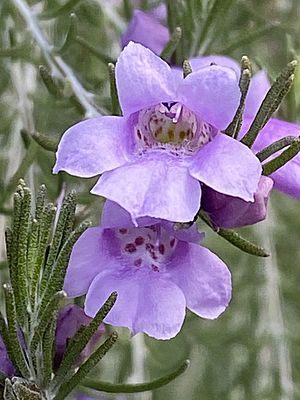Heath-like eremophila facts for kids
Quick facts for kids Heath-like eremophila |
|
|---|---|
 |
|
| This plant grows in the Mount Annan Botanic Garden. | |
| Conservation status | |
| Scientific classification | |
| Genus: |
Eremophila (plant)
|
| Species: |
microtheca
|
| Synonyms | |
|
|
The Eremophila microtheca, also known as heath-like eremophila, is a special flowering plant. It belongs to the figwort family, called Scrophulariaceae. This plant is found only in Western Australia, which means it is endemic to that area. It's a shrub that stands tall, has fuzzy branches and leaves, and produces pretty pale lilac flowers. You might also notice it has a strong smell!
Contents
What it Looks Like
Eremophila microtheca is a shrub that grows upright. It can reach a height of about 0.7 to 1.6 m (2 to 5 ft), which is like being as tall as a person. It gives off a strong scent. Its branches are covered with tiny, branched hairs, except for smooth (or glabrous) parts right under the leaves. The leaves are thin and long, almost like tiny cylinders. They are usually 6–16 mm (0.2–0.6 in) long and about 1 mm (0.04 in) wide.
The flowers grow one by one where the leaves meet the stem. Each flower sits on a small stalk that is 3–6 mm (0.1–0.2 in) long. Before the flower opens, it has 5 hairy, pointed parts called sepals, which are about 4–6 mm (0.16–0.24 in) long. The flower's petals are 10–15 mm (0.4–0.6 in) long. They are joined together at the bottom to form a tube shape. On the outside, the petals are pale lilac to purple, but inside, they are white with purple spots. The petal tube and its tips are smooth, except for a few hairs inside the tube. There are 4 stamens (the parts that make pollen) hidden completely inside the petal tube. This plant blooms from July to September. After the flowers, it grows dry, oval-shaped fruits that are wrinkled and smooth. These fruits are small, only 3–4 mm (0.1–0.2 in) long.
How it Got its Name
This plant was first officially described in 1882 by two scientists, Ferdinand von Mueller and George Bentham. They studied samples collected by Augustus Frederick Oldfield near Port Gregory. They first named the plant Pholidia microtheca. Later in 1882, Mueller changed its name to Eremophila microtheca.
The second part of its scientific name, microtheca, comes from two Ancient Greek words. Mikrós means "small," and thḗkē means "case" or "sheath." This name refers to the plant's small fruits.
Where it Lives
You can find Eremophila microtheca in damp areas between Kalbarri and Eneabba. These places are part of a natural area in Western Australia called the Geraldton Sandplains biogeographic region.
Conservation Status
The Government of Western Australia's Department of Parks and Wildlife has listed Eremophila microtheca as "Priority Four". This means the plant is rare or close to being threatened. It's important to protect these plants so they don't disappear!
Growing This Plant
People sometimes grow Eremophila microtheca because its blue or purple flowers are very pretty. However, its strong smell can be a problem, so it's best to plant it where the smell won't bother anyone. You can grow new plants from cuttings (small pieces of the plant) or by grafting them onto another plant's rootstock, like a Myoporum.
This plant can grow in most types of soil, even the clay soil where it naturally lives. It needs lots of sunshine to grow well. Once the plants are grown, they can handle long dry periods or even short floods. However, they don't do well in very humid places. They can also survive light frosts and can be lightly trimmed sometimes.


